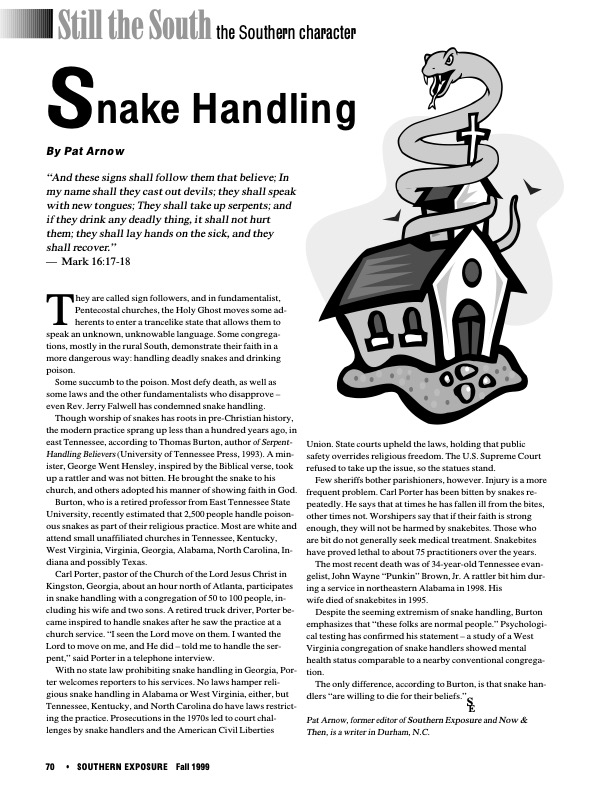from the “Still the South–Southern Character” column in Southern Exposure, Fall 1990
By Pat Arnow
“And these signs shall follow them that believe; In my name shall they cast out devils; they shall speak with new tongues; They shall take up serpents; and if they drink any deadly thing, it shall not hurt them; they shall lay hands on the sick, and they shall recover.”
— Mark 16:17-18
They are called sign followers, and in fundamentalist, Pentecostal churches, the Holy Ghost moves some ad- herents to enter a trancelike state that allows them to speak an unknown, unknowable language. Some congregations, mostly in the rural South, demonstrate their faith in a more dangerous way: handling deadly snakes and drinking poison.

Some succumb to the poison. Most defy death, as well as some laws and the other fundamentalists who disapprove – even Rev. Jerry Falwell has condemned snake handling.
Though worship of snakes has roots in pre-Christian history, the modern practice sprang up less than a hundred years ago, in east Tennessee, according to Thomas Burton, author of Serpent- Handling Believers (University of Tennessee Press, 1993). A minister, George Went Hensley, inspired by the Biblical verse, took up a rattler and was not bitten. He brought the snake to his church, and others adopted his manner of showing faith in God.
Burton, who is a retired professor from East Tennessee State University, recently estimated that 2,500 people handle poisonous snakes as part of their religious practice. Most are white and attend small unaffiliated churches in Tennessee, Kentucky, West Virginia, Virginia, Georgia, Alabama, North Carolina, Indiana and possibly Texas.
Carl Porter, pastor of the Church of the Lord Jesus Christ in Kingston, Georgia, about an hour north of Atlanta, participates in snake handling with a congregation of 50 to 100 people, in- cluding his wife and two sons. A retired truck driver, Porter became inspired to handle snakes after he saw the practice at a church service. “I seen the Lord move on them. I wanted the Lord to move on me, and He did – told me to handle the serpent,” said Porter in a telephone interview.
With no state law prohibiting snake handling in Georgia, Por- ter welcomes reporters to his services. No laws hamper religious snake handling in Alabama or West Virginia, either, but Tennessee, Kentucky, and North Carolina do have laws restricting the practice. Prosecutions in the 1970s led to court challenges by snake handlers and the American Civil Liberties Union. State courts upheld the laws, holding that public safety overrides religious freedom. The U.S. Supreme Court refused to take up the issue, so the statues stand.
Few sheriffs bother parishioners, however. Injury is a more frequent problem. Carl Porter has been bitten by snakes repeatedly. He says that at times he has fallen ill from the bites, other times not. Worshipers say that if their faith is strong enough, they will not be harmed by snakebites. Those who are bit do not generally seek medical treatment. Snakebites have proved lethal to about 75 practitioners over the years.
The most recent death was of 34-year-old Tennessee evangelist, John Wayne “Punkin” Brown, Jr. A rattler bit him during a service in northeastern Alabama in 1998. Hiswife died of snakebites in 1995.
Despite the seeming extremism of snake handling, Burton emphasizes that “these folks are normal people.” Psychological testing has confirmed his statement – a study of a West Virginia congregation of snake handlers showed mental health status comparable to a nearby conventional congregation.
The only difference, according to Burton, is that snake handlers “are willing to die for their beliefs.”
S E